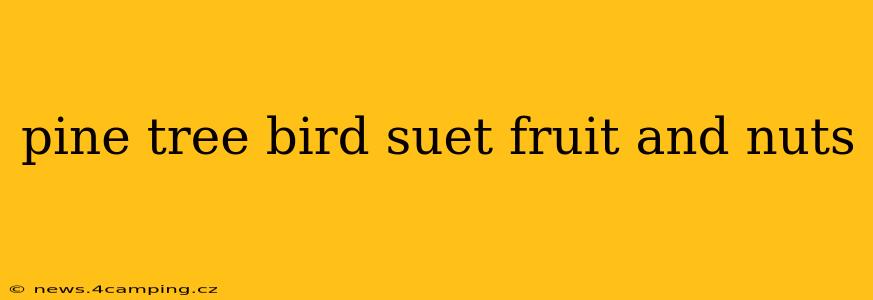Many bird species frequent pine trees, drawn to their shelter and the potential for food. Supplementing their natural food sources with suet, fruit, and nuts can significantly enhance your backyard birdwatching experience. This guide explores the best ways to attract birds to pine trees using these supplementary foods, focusing on safety and effectiveness.
What Birds Frequent Pine Trees?
Pine trees offer excellent nesting and roosting sites, attracting a diverse range of birds. Common visitors include:
- Woodpeckers: These birds are drawn to the insects living in the bark and are also fond of suet.
- Chickadees & Titmice: These smaller birds will happily consume suet, nuts, and even small pieces of fruit.
- Nuthatches: Expert climbers, nuthatches will explore the tree's crevices for insects and readily take advantage of offered nuts and seeds.
- Jays: Larger birds, jays may utilize pine trees for shelter and will consume nuts and fruits.
- Finches: Depending on the species, finches may forage among the needles and will appreciate sunflower seeds and other small seeds offered in feeders.
What Type of Suet is Best for Pine Tree Birds?
While various suet types exist, those with added nuts and seeds prove most attractive to birds frequenting pine trees. Look for suet cakes containing:
- Sunflower Seeds: A favorite for many bird species.
- Peanuts: Provide protein and healthy fats.
- Insects: Adding dried insects or mealworms enhances the nutritional value, especially for insect-eating birds like woodpeckers.
- Fruit pieces: Dried cranberries, raisins, or chopped apples add variety.
How to Offer Suet in Pine Trees?
Directly placing suet on a pine tree branch isn't always practical. Consider these options for presenting suet effectively:
- Suet Feeders: Hang suet feeders from sturdy branches, ensuring they're securely fastened and out of reach of predators like squirrels and cats.
- Suet Cages: Cages offer extra protection against larger birds and mammals, letting only smaller birds feed safely.
- Suet Balls: Place suet balls within the branches of the tree, securing them lightly with twine. This is an effective option for smaller, well-established pine trees, enabling easier access for birds.
What Fruits and Nuts Are Suitable?
A variety of fruits and nuts complement suet and attract a wider range of bird species. Consider offering:
- Sunflower Seeds: These are a staple and extremely popular with many birds.
- Peanuts (in the shell or shelled): Offer a rich source of protein and fat. However, ensure peanuts are unsalted.
- Mixed Nuts: A blend of walnuts, pecans, and almonds provides variety.
- Dried Fruits (raisins, cranberries, chopped apples): Provide natural sugars and fiber. Avoid overly sugary or processed options.
- Berries: Fresh or frozen berries such as blueberries, raspberries, or cherries attract various species. Place them in a shallow dish to avoid them sinking into the ground.
Where Should I Place Fruit and Nuts Near Pine Trees?
Similar to suet, you need to consider the placement of fruit and nuts strategically. Consider:
- Platform Feeders: A raised platform allows birds to safely feed without being preyed upon.
- Scattering on the Ground (Caution): While simpler, this method attracts rodents and larger birds that might deter smaller birds.
- Shallow Dishes: Placing fruits in shallow dishes elevates them slightly, keeping them cleaner and preventing them from getting soggy.
How Often Should I Replenish Food?
The frequency of replenishment depends on the number of birds visiting your pine tree and the amount of food offered. Regularly check the feeders and replenish as needed, keeping food fresh and free from mold or spoilage.
What are the Benefits of Supplying Suet, Fruit, and Nuts?
Providing supplementary food in your pine tree offers several benefits:
- Attracts a Wider Variety of Birds: Enhances your birdwatching experience.
- Provides Supplemental Nutrition: Especially beneficial during harsh weather or breeding seasons.
- Supports Bird Populations: Offers much-needed energy for survival and reproduction.
Are There Any Potential Drawbacks?
While providing food offers numerous benefits, be aware of potential drawbacks:
- Attracting Unwanted Pests: Rodents or larger birds might also be drawn to the food sources.
- Disease Transmission: Keep feeders clean to prevent the spread of diseases among birds.
- Dependence on Artificial Food Sources: Birds can become overly dependent on supplied food, leading to potential problems if food sources become scarce.
By understanding the preferences of birds frequenting pine trees and utilizing appropriate feeding methods, you can create a vibrant and thriving bird habitat right in your backyard. Remember to prioritize bird safety and maintain cleanliness to ensure a healthy and enjoyable experience for both you and your feathered friends.
